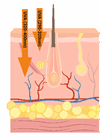The sustained global interest in regenerative medicine is evident and increasingly aligned to the emerging field of regenerative aesthetics [1]. Arguably, regenerative medicine is an established and evolving specialism of medicine, and the rise of associated medical aesthetic treatments and topical ingredients that can provide regenerative benefits is growing exponentially [2].
Regenerative aesthetics can address a variety of anti-ageing concerns through advanced biological interventions, which include stem cell, exosome therapy, polynucleotides, as well as bioactive peptides, among others [3]. The regenerative discussion has given rise to interest in skin treatments which can improve a variety of ‘skin quality’ concerns. Medical professionals should provide clarity around terminology in defining ‘skin quality’ and associated concerns to patients as many ageing skin changes can be positioned under this term [4]. This paper will focus on the evidence and benefits of topical peptides in successfully treating intrinsic and extrinsic cutaneous changes.
What are peptides?
Peptides are fragments of proteins that carry out biological functions and can be considered as signals to our cells that facilitate and communicate key messages and processes that regulate key biological processes [5]. These benefits are largely due to their high selectivity and specific interactions with their targets [6]. Peptides have consistently demonstrated diverse physiological effects, including antioxidant, anti-ageing, moisturising, collagen stimulating, and wound healing properties [7], exerting their biological functions in several different ways, which can be determined in part by their structure [8]. These functions determine how peptides can be categorised, and it can be useful to consider them in the following ways, according to their mechanism of action:
- Signal peptides: Stimulate collagen and elastin synthesis, as well as keratinocytes and epidermal cell proliferation, and modulate melanogenesis [9].
- Carrier peptides: Deliver trace elements to the skin, essential for wound healing and enzyme processes, and improve skin elasticity [10].
- Neurotransmitter inhibitor peptides: Inhibit the release of neurotransmitters that cause muscle contraction, thereby reducing fine lines and wrinkles [11].
- Enzyme inhibitor peptides: Inhibit the activities of enzymes that break down collagen, supporting the health of skin structure [12].
- Anti-microbial peptides: Protect against microorganisms including bacteria, fungi, and viruses by disrupting their membranes [13].
Signal peptides
Signal peptides produce their regenerative benefit by enhancing collagen production. The origin of the name of this type of peptides is based on their capabilities to signal, or emulate, the production of extracellular matrix proteins [7]. In addition, specific signal peptides, such as palmitoyl oligopeptide, have been developed to stimulate elastin synthesis, which further synergises and complements the overall regenerative benefits of signalling peptides [14].
Carrier peptides
The key benefits of these types of peptides are their collagen synthesis and collagenase inhibition properties [15]. The first commercialised carrier peptide was formulated to deliver copper, which is a trace element necessary for wound healing, into wounded tissue [14]. It is widely acknowledged for its key benefits in healing and repair [15]. The exact mechanisms of action are specific to proprietary formulations; however, it supports essential biologic processes necessary for tissue regeneration.
Neurotransmitter inhibitor peptides
A novel indication for the use of topical peptides is to target localised lines and cutaneous wrinkle formation. This benefit is often effective as a standalone topical regimen but synergises well alongside medical injectable procedures. A commonly used neurotransmitter peptide is acetyl hexapeptide-8 (Argireline®) [15]. Peptides exert these benefits in skincare by reducing the action of acetylcholine, which gradually softens the appearance of lines and wrinkles in skin [14].
Enzyme-inhibitory peptides
Enzyme-inhibitor peptides are effective at inhibiting the action of matrix metalloproteinases as well as stimulating the synthesis of hyaluronan [16]. An example which is used in skincare is Oligopeptide-68 [17], as well as tripeptide-10-citrulline [18]. Matrix metalloproteinases are zinc-containing endopeptidases with an extensive range of substrate specificities [19]. Collectively, these enzymes are able to degrade various components of extracellular matrix proteins, and subsequently these alterations will contribute towards skin ageing. These peptides are highly effective at protecting the integrity of key structures with the skin.
Antimicrobial peptides
Antimicrobial peptides (AMPs) are key factors in the body’s natural defence against pathogens [20]. Their diverse spectrum of activity against microbial pathogens makes them attractive candidates for treating skin diseases such as acne [21]. Human skin naturally produces AMPs, which can positively support a health microbiome when applied topically [21]. These peptides demonstrate proven effect in regulating and balancing the microbial load on the skin, while reducing inflammation.
Stability
Stability of peptide formulations remains a significant challenge due to several extrinsic influences [22]. Environmental factors such as heat, light, and oxygen, as well as enzymatic degradation, can compromise peptide stability. One of the most common types of modification for enhancing peptide stability is cyclisation, which involves forming a linkage between the amino and acid carboxy-groups in the N- and C-termini, by forming a linkage between two amino acid chains [23].
Innovative technologies
Myristoyl-pentapeptide-16 is a unique and intelligent patented peptide which is designed to stimulate cell renewal regenerative processes in the skin. The structure of the peptide allows for effective and targeted penetration due to the chemical structure which leads to the formation of hydrophylic micelles, which functions as a delivery system [24]. Micelles enable stimulation of growth factors, promote the proliferation of new cells to result in improved skin barrier function, which results in a reduction in trans-epidermal water loss. This peptide also encourages increased moisture retention, facilitates active encapsulation for enhanced synergistic ingredient delivery and boosts the skin’s protection against oxidative stress. In addition, myristoyl-pentapeptide-16 demonstrates upregulation of epidermal growth factor receptor as well as superoxide dismutase and antimicrobial protein expression.
Conclusion
Topical peptides are a diverse and innovative class of ingredients, with a breadth of regenerative benefits and functions. These biomimetic ingredients are an effective and proven topical treatment, suitable for all skin types. They deliver both standalone, as well as synergistic benefits to bring out the best of any treatment outcome, with an excellent safety profile. These technologies are an exciting addition into the medical aesthetic field, delivering exceptional results and anti-ageing benefits.
References
1. Goldie K. The evolving field of regenerative aesthetics. J Cosmet Dermatol 2023;22(Suppl 1):1–7.
2. Zarbafian M, Fabi SG, Dayan S, Goldie K. The emerging field of regenerative aesthetics – where we are now. Dermatol Surg 2022;48(1):101–8.
3. Rahman E, Carruthers JDA, Rao P, et al. Regenerative aesthetics: a genuine frontier or just a facet of regenerative medicine: a systematic review. Aesthetic Plast Surg 2024; Epub ahead of print.
4. Humphrey S, Brown SM, Cross SJ, Mehta R. Defining skin quality: clinical relevance, terminology, and assessment. Dermatologic Surgery 2021;47(7):974–81.
5. Apostolopoulos V, Bojarska J, Chai TT, et al. A global review on short peptides: frontiers and perspectives. Molecules 2021;26(2):430.
6. Bojarska J. Amino acids and short peptides as anti-aging ‘superfood’. Int J Nutr Sci 2020;5:1039–44.
7. Errante F, Ledwoń P, Latajka R, et al. Cosmeceutical peptides in the framework of sustainable wellness economy. Front Chem 2020;8:572923.
8. Schagen SK. Topical peptide treatments with effective anti-aging results. Cosmetics 2017;4:16.
9. Skibska A, Perlikowska R. Signal peptides – promising ingredient in cosmetics. Curr Protein Pet Sci 2021;22(10):716–28.
10. Wang J, Wu Y, Chen Z, et al. Exogenous bioactive peptides have a potential therapeutic role in delaying aging in rodent models. Int J Mol Sci 2022;23(3):1421.
11. Choi HY, Lee YJ, Kim CM, Lee Y-M. Revolutionizing cosmetic ingredients: harnessing the power of antioxidants, probiotics, plant extracts, and peptides in personal and skin care products. Cosmetics 2024;11:157.
12. Resende DISP, Ferreira MS, Sousa-Lobo JM, et al. Usage of synthetic peptides in cosmetics for sensitive skin. Pharmaceuticals 2021;14:702.
13. Mazurkiewicz-Pisarek A, Baran J, Ciach T. Antimicrobial peptides: challenging journey to the pharmaceutical, biomedical, and cosmeceutical use. Int J Mol Sci 2023;24(10):9031.
14. Ngoc LTN, Moon JY, Lee YC. Insights into bioactive peptides in cosmetics. Cosmetics 2023;10:111.
15. Waszkielewicz AM, Mirosław K. Peptides and their mechanisms of action in the skin. Appl Sci 2024;14:11495.
16. Sim GS, Lee DH, Kim JH, et al. Black rice (Oryza Sativa L. Var. Japonica) hydrolyzed peptides induce expression of hyaluronan synthase 2 gene in HaCaT keratinocytes. J Microbiol Biotechnol 2007;17:271–9.
17. Liu M, Chen S, Zhang Z, et al. Anti-ageing peptides and proteins for topical applications: a review. Pharma Dev & Tech 2022;27(1):108–25.
18. Raikou V, Varvaresou A, Panderi I, Papageorgiou E. The efficacy study of the combination of tripeptide-10-citrulline and acetyl hexapeptide-3. A prospective, randomized controlled study. J Cosmet Dermatol 2017;16(2):271–8.
19. Pittayapruek P, Meephansan J, Prapapan O, et al. Role of matrix metalloproteinases in photoaging and photocarcinogenesis. Int J Mol Sci 2016;17(6):868.
20. Ma Z, Kochergin N, Olisova O, Snarskaya E. Topical antimicrobial peptides in combined treatment of acne patients. J Cosmet Dermatol 2022;21:1533–8.
21. Rademacher F, Gläser R, Harder J. Antimicrobial peptides and proteins: Interactions with the skin microbiotia. Exp Derma 2021;30(10):1496–508.
22. Jiménez-Rodríguez A, Guardado-Félix D, Antunes-Ricardo M. Challenges and strategies for topical and transdermal delivery of bioactive peptides. Crit Rev Ther Drug Carrier Syst 2022;39(1):1–31.
23. Ledwoń P, Errante F, Papini AM, et al. Peptides as active ingredients: a challenge for cosmeceutical industry chem. Biodiversity 2021;18:e2000833.
24. Dominguez S, Mackert GA, Dobke MK. Chapter 29 – Nanotechnology to enhance transdermal delivery of hydrophilic humectants for improved skin care: a model for therapeutic applications. In: Andronescu E, Grumezescu AM (Eds). Nanostructures for Drug Delivery: A Volume in Micro and Nano Technologies Elsevier Inc; 2017.
Declaration of competing interests: The author has received honoraria for speaking on peptide-based skincare technologies for HydroPeptide at a conference in Prague in October 2024.









